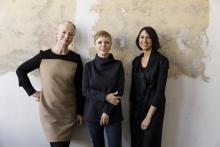
Inside Outside, with its multi-disciplinary team of architects, landscape- and interior designers and artists, was founded by Petra Blaisse in 1991. The fact that the studio combines interior and landscape works that both complement and challenge their architectural context, have given Blaisse's studio its international recognition.
Choreographing movement, composing trajectories, organizing viewpoints (both in- and outward) and creating inviting effects to trigger the viewer's curiosity and surprise, the studio combines traditional 'landscape' methods with a contemporary mentality. With colour, light, sound, textiles, textures, plant material and the effects of time, the environments Inside Outside creates become dynamic and sensual experiences. The team’s love for hands-on work, technical tools and mechanical materials such as tracks, motors, building structures and 'bio' materials, broadens their interest from the aesthetic to the technical. Their passion for nature in its most diverse form, combined with their love for gardening, makes that Inside Outside introduces rich plantings and biodiversity into the urban realm wherever they can – for educational and environmental reasons; but as much to offer an ever-changing landscape with a multitude of sensations. With a general interest in learning and researching - necessary when working in various climates, cultures and time-zones - Inside Outside stands for perpetual development.
Working internationally since the very beginning, Inside Outside studio has developed landscape designs in a variety of scales and levels of complexity (from private gardens to landscape master plans), in different climate zones and working in varied forms of collaboration worldwide. Gathering and exchanging knowledge and craftsmanship with local parties, Inside Outside combines research and technical sophistication with inventiveness. Their work responds to each new context, program and culture, resulting in dynamic, layered and site specific designs. Both inside and out, the studio thus creates both lyrical and efficient conditions that not only answer to complex technical requirements, but that also introduce new ways of use and continuously changing experiences – today and in the future.








